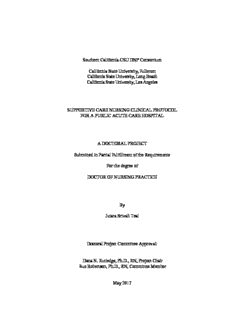
Palliative Care Nursing Clinical Protocol for a Public Acute Care Hospital PDF
Preview Palliative Care Nursing Clinical Protocol for a Public Acute Care Hospital
Southern California CSU DNP Consortium California State University, Fullerton California State University, Long Beach California State University, Los Angeles SUPPORTIVE CARE NURSING CLINICAL PROTOCOL FOR A PUBLIC ACUTE CARE HOSPITAL A DOCTORAL PROJECT Submitted in Partial Fulfillment of the Requirements For the degree of DOCTOR OF NURSING PRACTICE By Jutara Srivali Teal Doctoral Project Committee Approval: Dana N. Rutledge, Ph.D., RN, Project Chair Sue Robertson, Ph.D., RN, Committee Member May 2017 Copyright Jutara Srivali Teal 2017 © ii ABSTRACT Seriously ill patients may require palliative nursing care that may be offered independently or in collaboration with palliative medical care. World-wide, approximately 40 million people require palliative care but only about 14% of those individuals receive it (World Health Organization, 2015). In a public 670-bed acute care hospital, palliative care consultation requires a physician's order and thus may arrive late in an illness trajectory. Acute care nurses may not be confident or proficient in providing palliative care. A palliative care knowledge survey in the local setting confirmed nurses’ knowledge deficit. A Supportive Care Nursing Clinical Protocol (SCNCP) was developed as a knowledge tool to meet the needs of acute care nurses providing care for seriously ill patients. The term “supportive care” is used instead of palliative care to avoid the stigma of palliative care and its potential tie with end-of-life (Cherny, 2009). The SCNCP is based upon national guidelines and scientific evidence. The SCNCP guides nurses to assess physiological, psychosocial, and spiritual factors commonly experienced by patients living with serious illness. Evidence-based nursing interventions in the SCNCP include using select complementary interventions including a thirst bundle, hand-held fan for dyspnea, and the use of mobile phone applications (apps) are suggested for mindfulness, relaxation, distraction, and coping. Approvals for the protocol have been iii made by the Nursing Protocol Committee, Professional Practice Committee, and the Nursing Executive Council. Implementation of the SCNCP is projected for Spring 2017. iv TABLE OF CONTENTS ABSTRACT ................................................................................................................... iii LIST OF TABLES ......................................................................................................... vii LIST OF FIGURES ....................................................................................................... viii ACKNOWLEDGMENTS ............................................................................................. ix BACKGROUND ........................................................................................................... 1 Problem Statement ................................................................................................ 4 Purpose Statement................................................................................................. 7 Supporting Framework ......................................................................................... 8 REVIEW OF LITERATURE ........................................................................................ 12 Barriers to Palliative Care in Acute Care Hospitals ............................................. 12 Health Care Personnel as Barriers ........................................................................ 14 Patient and Family Factors as Barriers ................................................................. 15 Resource Allocation as a Barrier .......................................................................... 16 METHODS .................................................................................................................... 18 Recipients.............................................................................................................. 19 Innovation ............................................................................................................. 21 Inner Context ........................................................................................................ 26 Outer Context ........................................................................................................ 27 RESULTS ...................................................................................................................... 28 Palliative Care Quiz Results ................................................................................. 28 Protocol Approval Process.................................................................................... 29 Summary ............................................................................................................... 31 v DISCUSSION ................................................................................................................ 30 Protocol Launch Plans: Recommendations .......................................................... 31 Evaluation Plan ..................................................................................................... 32 Implications for Practice ....................................................................................... 33 SUMMARY ................................................................................................................... 35 REFERENCES .............................................................................................................. 37 APPENDIX A: MANUSCRIPT FOR HOLISTIC NURSING PRACTICE ............... 52 APPENDIX B: AUTHOR GUIDELINES FOR HNP ................................................ 68 APPENDIX C: PALLIATIVE CARE QUIZ .............................................................. 76 APPENDIX D: SUPPORTIVE CARE PROTOCOL.................................................. 77 APPENDIX E: TABLE OF EVIDENCE.................................................................... 84 APPENDIX F: PERMISSION TO USE iPARIHS .................................................... 97 APPENDIX G: IRB EXEMPTION ............................................................................. 98 vi LIST OF TABLES Table Page 1. Strategies for Assessments in SCNCP ................................................................. 24 vii LIST OF FIGURES Figure Page 1. Palliative care continuum..................................................................................... 2 2. Decision to apply SCNCP ................................................................................... 8 3. The Promoting Action on Research Implementation in Health Services integrated framework (iPARIHS) ........................................................................ 11 4. PRISMA flow diagram: Barriers to hospital-based palliative care ..................... 13 5. Palliative Care Quiz results.................................................................................. 30 viii ACKNOWLEDGMENTS Special thanks to Dr. Dana Rutledge and Dr. Sue Robertson for all the support and encouragement that made this work possible. Their wisdom and enthusiasm for scholarship guided a DNP journey that is rich with inquiry and discovery. Thanks also goes to the palliative care clinical nurse specialist, Eve Cruz, who provided clinical expertise to the project. Her genuineness as a nurse and a friend made the DNP project a clinically meaningful experience. There would not be today without my parents. Mumsy, thank you for my nursing genes and for being a creative role model. Dadsy, thank you for the gift of perseverance and for never doubting me. Most of all, thanks go to my husband, Bill, without whom my life would be fragmented and incomplete. ix 1 BACKGROUND Palliative care is specialized care for people living with serious illness which focuses on providing relief from the symptoms and stress of a serious illness. Palliative care provision likely results in a higher quality of life (Institute of Medicine [IOM], 2014). At a public university-affiliated hospital in Los Angeles, palliative care consultation requires a physician referral. However, physician referral to palliative care services is often slow (Humphreys & Harman, 2014) and acute care nurses lack palliative care knowledge (Shea, Grossman, Wallace, & Lange, 2010; White, Roczen, Coyne, & Wiencek, 2014). The terms palliative care, hospice care, and end-of-life (EOL) care are sometimes used interchangeably. While there are similarities among the terms, the differences are important in a discussion of care delivery. Palliative care is both a philosophy of care, and an organized, highly structured system for delivering care ("National Consensus Project for Quality Palliative Care: Clinical Practice Guidelines for Quality Palliative Care, Executive Summary," 2004). Palliative care conveys the comprehensiveness of care of the person and family as a unit of care once complex health problems of serious illness arise (Hanks, 2008). Such care can begin as soon as the patient with a serious or life- limiting illness enters an advanced stage (Hui et al., 2013). End-of-life care often reflects a disease-centered perspective based on a period when there is irreversible decline towards death (Hui et al., 2014). In the United States, hospice care is specialized care that Medicare beneficiaries (Medicare Hospice Data, 2016) are qualified to receive once a physician certifies a patient to have a prognosis of six months or less to live (Stevenson, 2012). Hospice care usually takes place at home or
Description: